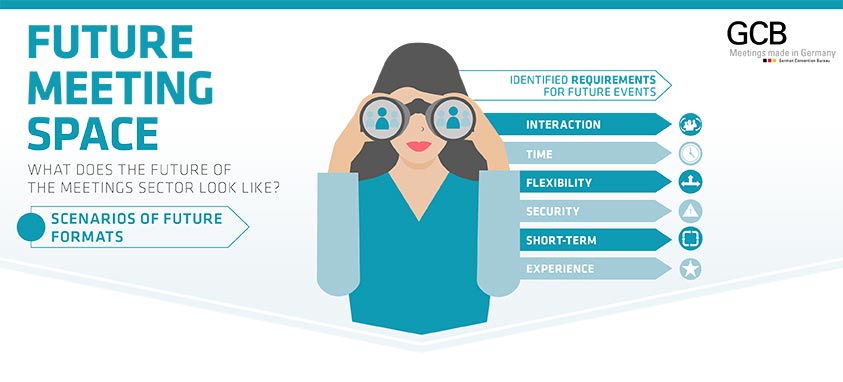Will meetings of the future go “off the grid” or become even more closely linked with day-to-day work and technology? How will online groups meet face-to-face and how are hybrids shaping up?
As part of its Future Meeting Space research project, which is being completed in partnership with European Association of Event Centres and Fraunhofer Institute of Industrial Engineering, the German Convention Bureau will address these questions and others through a series of hypothetical conference scenarios.
Six great ideas for very different conference types are presented in infographic form below. Infographics courtesy of German Convention Bureau.
Interactive Forum
Meetings of up to 200 participants start with plenaries which provide a road map for discussion, then participants break into small groups to dive deeper, debate and build on these topics. World Cafés and gamification could work will with this setup. Reactions and ideas are aggregated and shared with the group to create connections, highlight common challenges and opportunities, and identify next steps.

Unplugged
Rather than staying tightly tethered to the office, the unplugged meeting deliberately picks a remote location where up to 50 participants can disconnect from daily work demands and outside distractions. Locations can be rural, or “off the grid” urban venues. This setup does not encourage a lot of technology & device use during the meetings, but knowledge sharing is very concentrated.

Co-Working
Keeping in mind that it’s hard to step away from responsibilities back at the office, this format spreads meeting modules over a longer number of days and provides dedicated working spaces and time to attend to items at the office. Attendees are more autonomous in this unconference-like format, yet they still remain focused on meeting goals. Extended stays mean more opportunities to network and share knowledge informally.

Virtual to Physical
In this approach, a group that has only worked together online comes together in person to meet and share knowledge. The purpose is to create deeper individual and group connections which will enrich future online interactions.

Multisite
A main meeting is held across several venues simultaneously, with about 50 people per venue. This enables face-to-face connections without forcing groups to endure long distance travel. Live video transmissions connect the meeting locations and people with a common core agenda, but individual locations can then also break off and discuss local and regional needs and interests as well. Event-specific online platforms, holograms and robots could be used for knowledge sharing across locations.

Hybrid
This model requires a physical meeting and conference space as well as a digital meeting room for individuals or groups. Both sets of participants have access to identical content, knowledge sharing and program flow in real time. Attendees are tuned in via laptops, desktops, mobile phones or tablets. Time and cost-savings are a focus here, as is unified content. Group discussions and networking are still very much in the mix.






